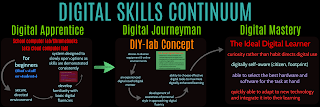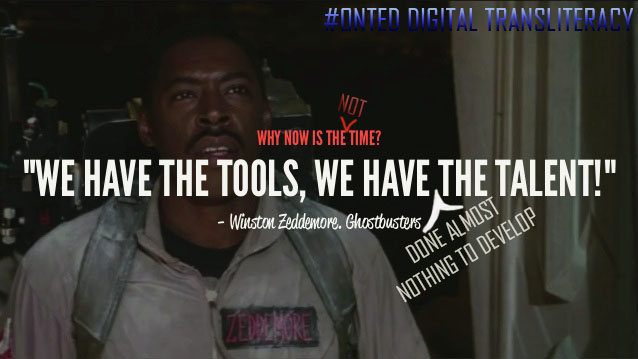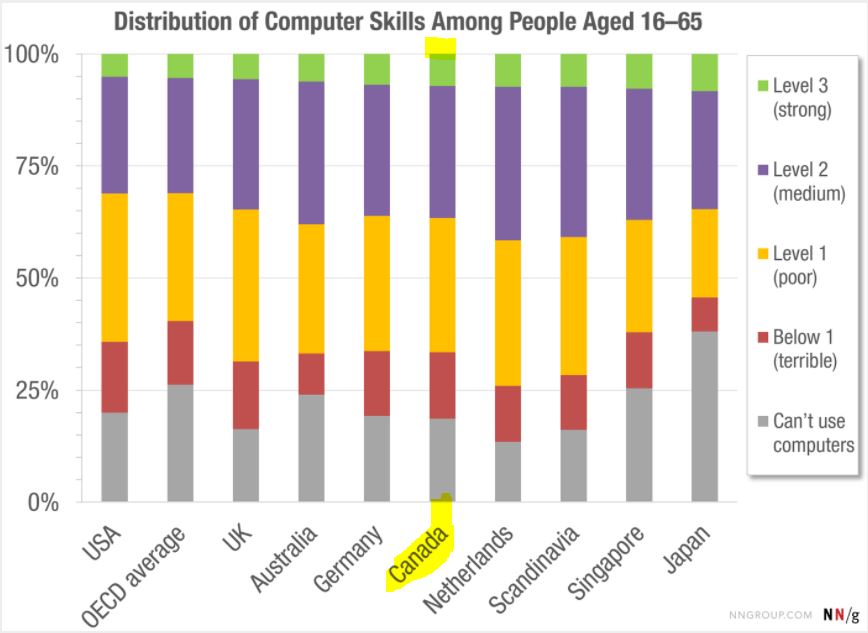The other week Alec Couros asked for predictions on what will come of this pandemic remote learning situation. I find myself straddling this divide. On the one side you have the powers that be who have no interest in changing a status quo that has put them in charge. On the other you have technology multinationals and the branded teachers who support them wanting to use this situation as an opportunity to push a more technology dependent evolution in schooling. In between them all are working teachers who are just trying to make this work.
Six years ago I found myself in Arizona at the Education Innovation (sic) Summit at the invitation of Wikispaces (who have since evaporated). I say sic because it had very little to do with education or innovation and a lot to do with market share and the rollout of an inflexible digital delivery system (or LMS if you prefer). There were a couple of comments from that conference that are resonating with me during this pandemic emergency response. I overheard a senior VP at a multi-national tech company you’d have heard of that likes to ‘certify’ and brand teachers say, “with the new common core curriculum and the charter school push, this is our moment to strike!” You could almost hear the drool hitting the floor from the predators who filled up this ‘education innovation’ summit. This should sound strangely familiar to Ontario educators after this past year.
An opposing moment came as a round table of Ph.Ds talked about data exhaust and tracking the vast improvements that have happened in education and learning thanks to our adoption of digital technology. The problem is that there is no such data. Countries that adopted digital technology in learning early on show little or no statistical change in learning outcomes. This is what happens when we adopt digital technology primarily to reduce photocopying budgets instead of applying pedagogy to leverage new communication mediums.
In the six years since that conference I’ve watched our school systems lurch toward the stake I claimed on the digital frontier, adopting wireless and cloud based technologies and expanding general student access to edtech, but the learning outcomes are seldom different because we have done little to improve digital transliteracy. Students who struggled before tend to actually struggle more in the poorly understood digital cesspool of conflicting mediums. Now that I’m teaching computer technology full time I see it happening on a province-wide basis; technology isn’t the great equalizer, it’s either hugely reductive or an invitation to chaos. Instead of adapting and engaging with new mediums and developing transliteracies around them, we’ve reduced digital technology to a cost saving measure that doesn’t actually save any money. We don’t teach digital fluency, we just magically expect it, and in the meantime we’re buying mounds of technology that almost no one knows how to leverage effectively.
At the end of 2019 a novel virus that we’ve never seen before began spreading across the world. Unchecked it would kill millions and overwhelm our austerity riddled medical systems. After a year of bullying Ontario education with absurd threats of mandatory elearning courses for all, COVID19 suddenly delivered the perfect opportunity to prove that it’s possible. What’s happening with remote learning right now isn’t designed to deliver the best possible learning outcomes using the all of the digital tools at our disposal, it’s a marketing exercise.
I’m in a position where I teach digital technology to a self selected group of students who are much more likely to be connected, have their own technology AND (most importantly!) know how to use it. In our first week of remote learning I’ve got eyes on every one of my students and a 100% engagement rate across all classes, but to use this as proof that elearning might work is the worst kind of skulduggery.
 When this all kicked off I was keen to move quickly, take initiative and demonstrate what our digital fluency could accomplish. While the rest of the system lost initiative in two weeks of silence, I had a number of students who were already crushing what would become the radically reduced expectations that the Ministry eventually worked out.
When this all kicked off I was keen to move quickly, take initiative and demonstrate what our digital fluency could accomplish. While the rest of the system lost initiative in two weeks of silence, I had a number of students who were already crushing what would become the radically reduced expectations that the Ministry eventually worked out.
Three hours of remote learning per week per course? We spend over six high bandwidth face to face hours a week in class and senior students usually drop another couple of hours in on top of that. Three hours of remote learning is a tiny fraction of this. How tiny? The introduction to networking piece we usually do in a blended online LMS and F2F grade 10 class on Cisco’s Netacademy takes one week to finish – I’ve given my remote learning grade 10s an entire month to do the same thing, and many won’t manage it, in some cases because the locked down Chromebooks they were shipped won’t install the software, in other cases because of a lack of space or time, and in others because without an adult present some students just won’t do anything. There are so many reasons why this shouldn’t work, but we keep adding more reasons on top.
If we prove this works at all (and many are having trouble reaching even that lowered target), we’ve proven that remote learning is only fractionally as effective as face to face learning, which was why so many teachers fought this government’s callous mandatory elearning push in the first place, and that’s not even getting into digital divides, equity and digital illiteracy. In a perfect case with carefully selected students with the tech, connectivity and skills required, remote learning is 25% as effective as what we usually do. In reality it won’t even come close to that.
***
My ‘let’s floor it and show everyone what digital fluency can do’ approach changed dramatically over the first few weeks as remote learning finally rolled out. Colleague Diane‘s comment in the union portion of our first online staff meeting (another impossibility – our union is famously anti-tech) began a shift in my thinking; this isn’t an opportunity to push elearning, it’s an emergency response. How we name it might sound pedantic, but it isn’t. Names carry implications, and even though Ontario’s emergency response remote learning is pretty much entirely elearning based, it shouldn’t be, as this article from the Broadbent Institute suggests…
“To roll out what has been a specialized program serving a minority of students to the majority of students in an emergency — sets up expectations against which we are poised to fail.”
“The provincial “Learn at Home” approach draws not only on a fantasy of eagerly connected students with ample resources, but also on a fantasy of home free from conflict and space constraints, supported by caregivers who can and will provide structure, motivation, and mediate learning between the teacher and their child.”
There is a lot of fantasy in how this is all unfolding. Over the years I’ve often found myself surrounded by perfectly operational computers that were destined for landfill. At one point I got our student success person on board and built free, Linux based computers to hand out to families in need – it was a disaster. When you hand out unfamiliar technology that people don’t know how to use, they don’t know how to use it – how’s that for a stunning revelation? We’ve just done logistical backflips on a system wide scale in Ontario during this remote learning crisis to do exactly that. How bad is digital fluency in Canadian society? Worse than you think. The belief that ‘digital natives’ who are familiar with habitual use of technology somehow have mastery of it is just another fantasy we can’t be bothered to dispel.
The remote learning push will be what it will be, and what it ends up being will be nothing remotely close to what it could have been thanks to our wilfully oblivious approach to digital divides and transliteracy. We’ve done what we always do: drastically simplify a complex situation for appearances, but it’s to be expected when a critical service like education is run by politics. Handing out books to illiterate people isn’t going to prompt a lot of reading – but that’s exactly what we’re expecting with our sudden onset elearning plan.
Other pedagogically focused educators I look to when reflecting and adjusting my teaching have also emphasized the importance of re-framing this situation away from a digital technology marketing opportunity. Zoe and Brenda have both emphasized the importance of a compassionate, considered approach rather than driving for curriculum consumption. Alanna’s blog post on social media distancing with students changed my mind about trying to recreate a classroom environment by driving for video chat access. Knowing that my students are digitally skilled and connected, I was frustrated when I didn’t have quick pickup from my seniors, only to discover that the quiet ones had suddenly been pressed into 40+ hours a week of reduced minimum wage work and were sorry for not doing the 3 hours per class that private school Stephen, who didn’t need a job in high school and most certainly never balanced a full time reduced minimum wage job during a pandemic, has decided is appropriate.
***
 Would I like to see us adopt a coherent digital skills curriculum with specifically identified and developed skills? Yes, I would. I’d like us to become authors of educational technology rather than just consumers or branded representatives of multi-nationals. I seek a nuanced, transliterative use of digital technology and an adaptive, self-aware pedagogy that leverages these new mediums of communication to maximize learning outcomes for everyone. I’ve been advocating for a digital apprenticeship for our students and staff for over a decade and I don’t see that changing, but using an emergency situation to push that agenda is inappropriate, and what we’ve done in terms of expecting miracles from it has cast a harsh light on our myopic approach to digital transliteracy to date.
Would I like to see us adopt a coherent digital skills curriculum with specifically identified and developed skills? Yes, I would. I’d like us to become authors of educational technology rather than just consumers or branded representatives of multi-nationals. I seek a nuanced, transliterative use of digital technology and an adaptive, self-aware pedagogy that leverages these new mediums of communication to maximize learning outcomes for everyone. I’ve been advocating for a digital apprenticeship for our students and staff for over a decade and I don’t see that changing, but using an emergency situation to push that agenda is inappropriate, and what we’ve done in terms of expecting miracles from it has cast a harsh light on our myopic approach to digital transliteracy to date.
The irony of this crisis is that it has improved digital transliteracy in one of the hardest to crack bastions of the education system. I’ve seen staff who I would never have imagined on video chats, and doing that while they’re also having to integrate unfamiliar digital tools in a live learning environment (such as it is). If Alec is still looking for a bright side in this, maybe this will be what comes of it; that more educators begin to understand the possibilities of digital transliteracy in learning. Maybe then enough educators will know enough about it to create a sea change in how we approach our digital divides, because it sure ain’t coming from the top down.
Related Material:
ECOO 2011 Presentation: Dancing in the Datasphere – we cling to outdated concepts of information and communication even as a digital revolution envelops us
ECOO 2016 Presentation: The DIY Computer Lab – differentiating technology use to raise digital fluency
2017: The Digital Divide is Deep & Wide – access to digitally enhanced learning is about much more than just technology and connectivity
2018: How To Resolve Poor Technical Fluency – courses that teach digital transliteracy are few and far between in Ontario classes, yet every class uses digital tools…
Digital Fluency: it kicked off Dusty World and is a recurring theme in it (because it has never been addressed)
from Blogger https://ift.tt/2xtJqnb
via IFTTT

























